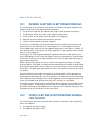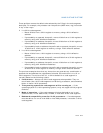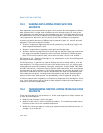
18-4 Vol. 3
MIXING 16-BIT AND 32-BIT CODE
18.3 SHARING DATA AMONG MIXED-SIZE CODE
SEGMENTS
Data segments can be accessed from both 16-bit and 32-bit code segments. When a
data segment that is larger than 64 KBytes is to be shared among 16- and 32-bit
code segments, the data that is to be accessed from the 16-bit code segments must
be located within the first 64 KBytes of the data segment. The reason for this is that
16-bit pointers by definition can only point to the first 64 KBytes of a segment.
A stack that spans less than 64 KBytes can be shared by both 16- and 32-bit code
segments. This class of stacks includes:
• Stacks in expand-up segments with the G (granularity) and B (big) flags in the
stack-segment descriptor clear.
• Stacks in expand-down segments with the G and B flags clear.
• Stacks in expand-up segments with the G flag set and the B flag clear and where
the stack is contained completely within the lower 64 KBytes. (Offsets greater
than FFFFH can be used for data, other than the stack, which is not shared.)
See Section 3.4.5, “Segment Descriptors,” for a description of the G and B flags and
the expand-down stack type.
The B flag cannot, in general, be used to change the size of stack used by a 16-bit
code segment. This flag controls the size of the stack pointer only for implicit stack
references such as those caused by interrupts, exceptions, and the PUSH, POP, CALL,
and RET instructions. It does not control explicit stack references, such as accesses
to parameters or local variables. A 16-bit code segment can use a 32-bit stack only if
the code is modified so that all explicit references to the stack are preceded by the
32-bit address-size prefix, causing those references to use 32-bit addressing and
explicit writes to the stack pointer are preceded by a 32-bit operand-size prefix.
In 32-bit, expand-down segments, all offsets may be greater than 64 KBytes; there-
fore, 16-bit code cannot use this kind of stack segment unless the code segment is
modified to use 32-bit addressing.
18.4 TRANSFERRING CONTROL AMONG MIXED-SIZE CODE
SEGMENTS
There are three ways for a procedure in a 16-bit code segment to safely make a call
to a 32-bit code segment:
• Make the call through a 32-bit call gate.
• Make a 16-bit call to a 32-bit interface procedure. The interface procedure then
makes a 32-bit call to the intended destination.
• Modify the 16-bit procedure, inserting an operand-size prefix before the call, to
change it to a 32-bit call.


















